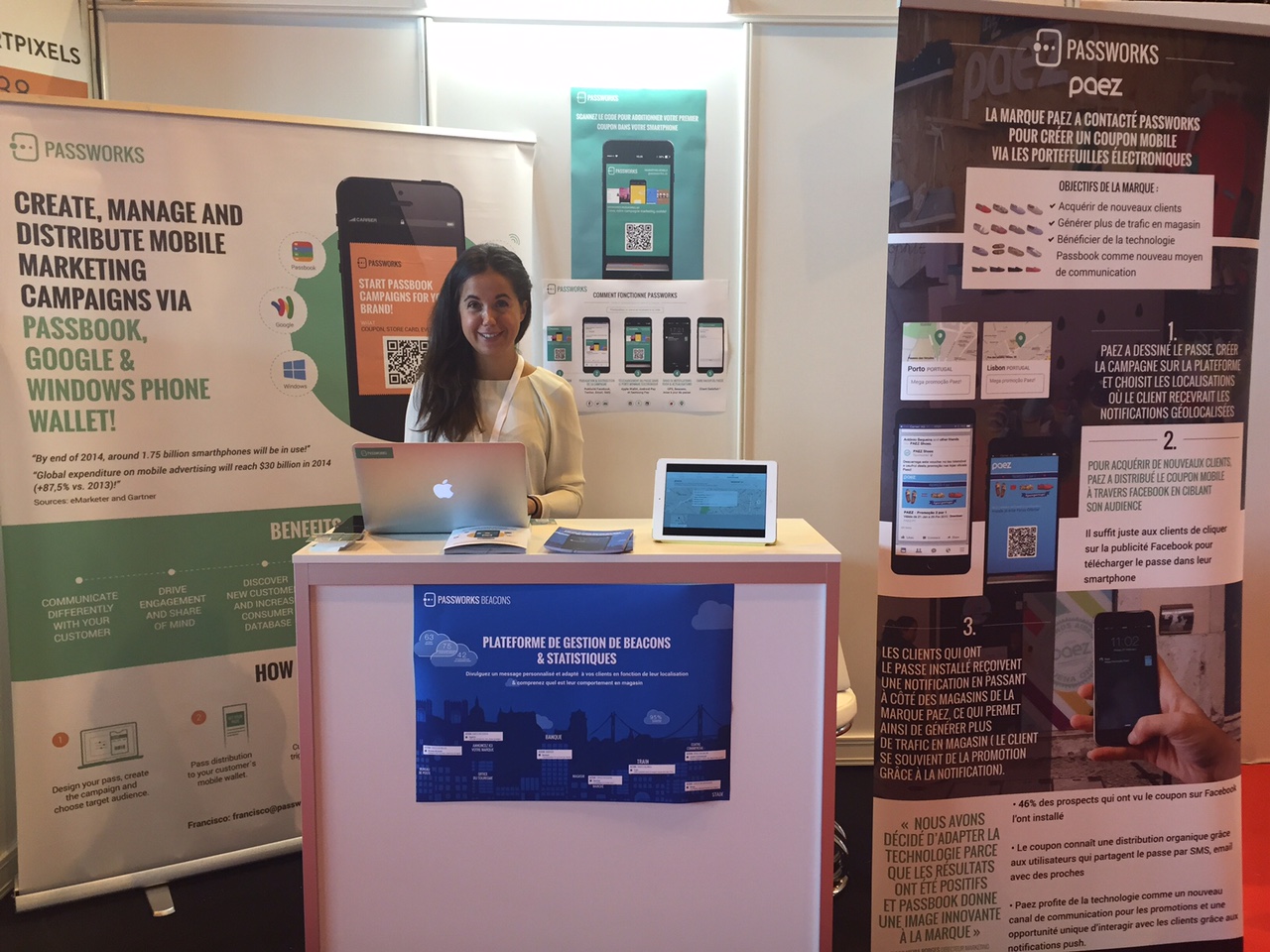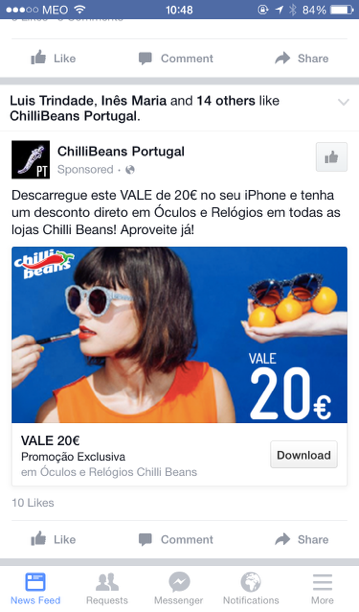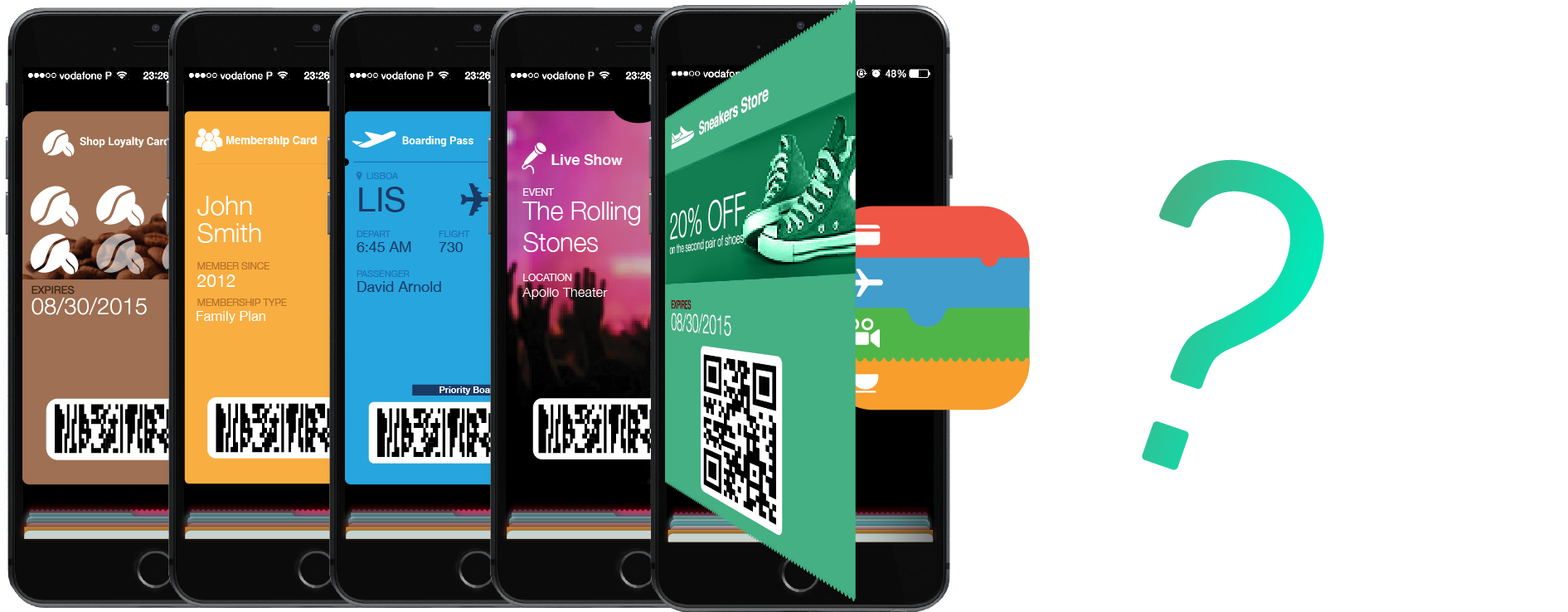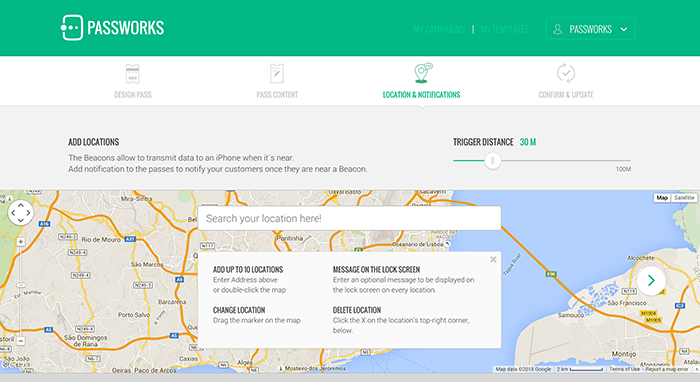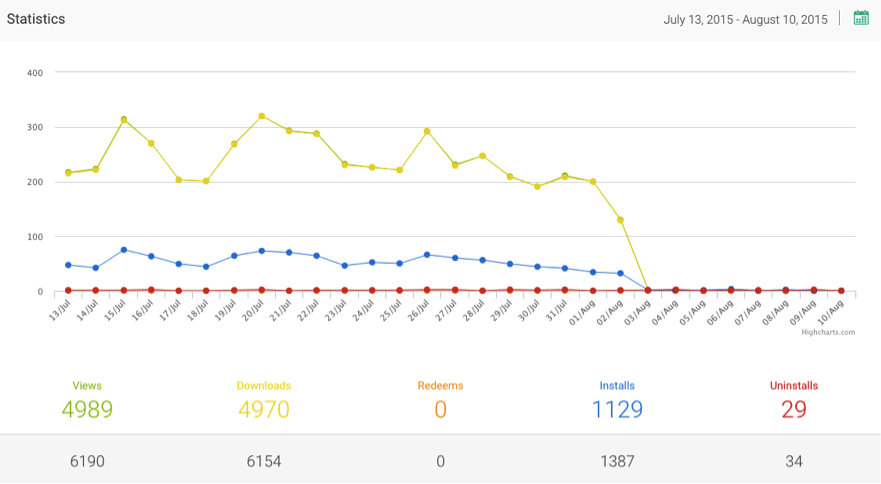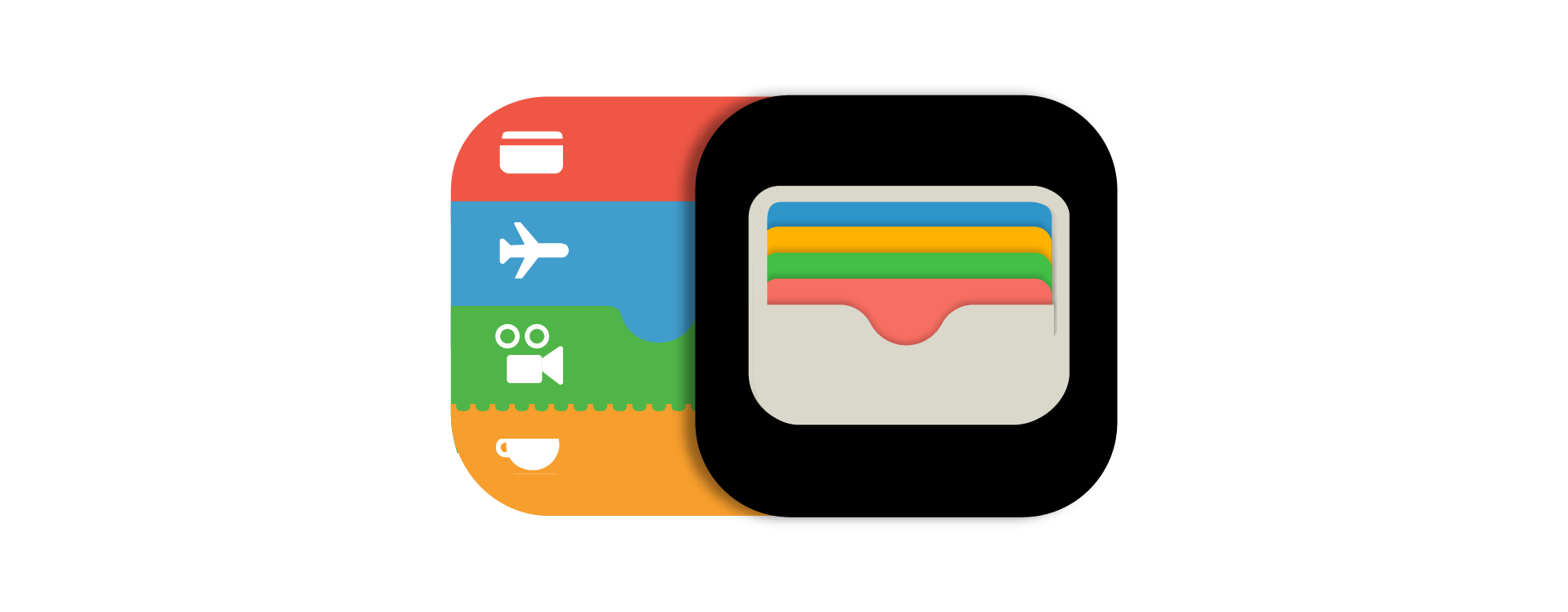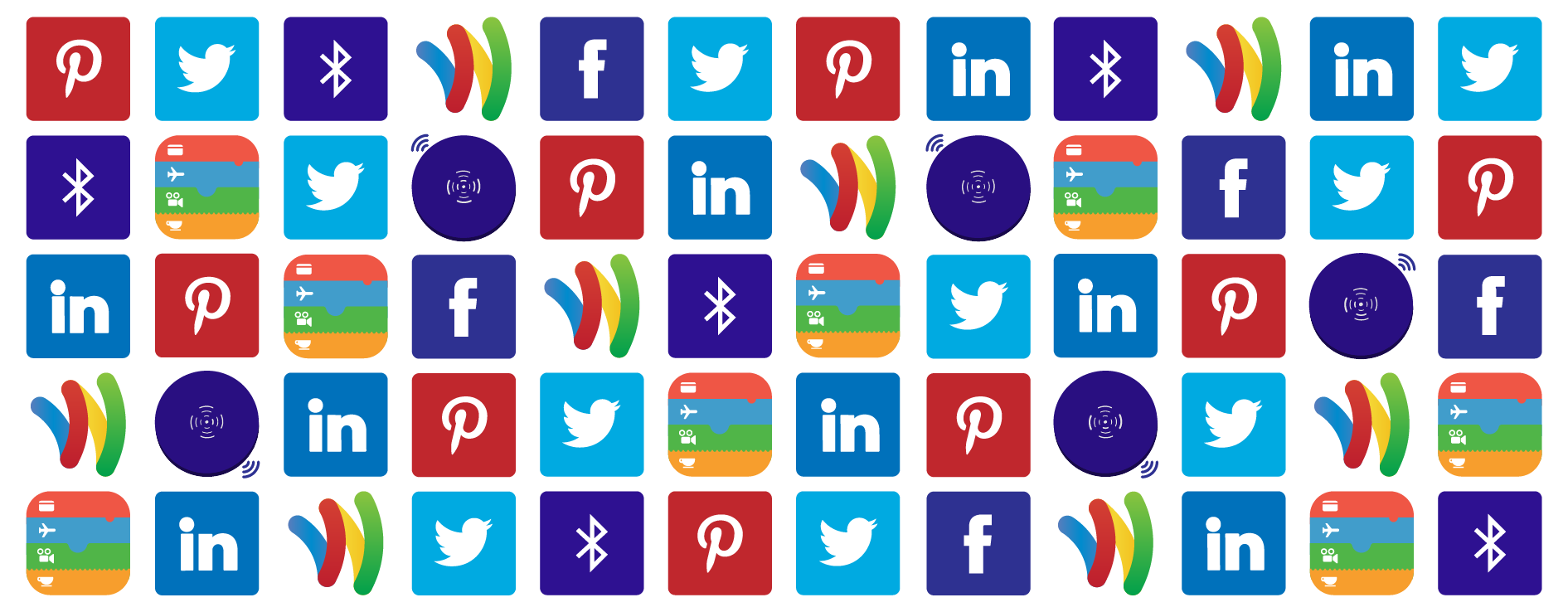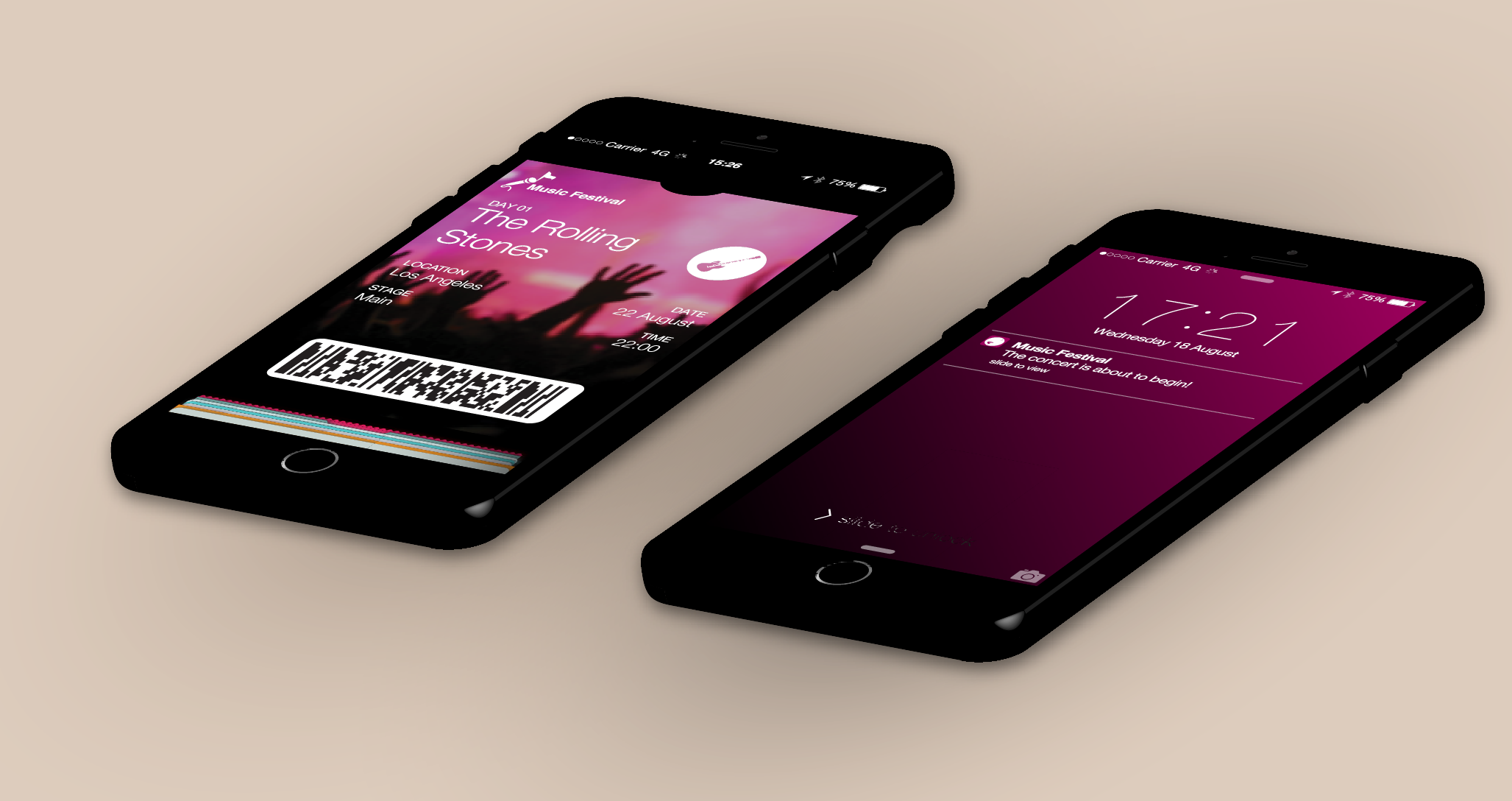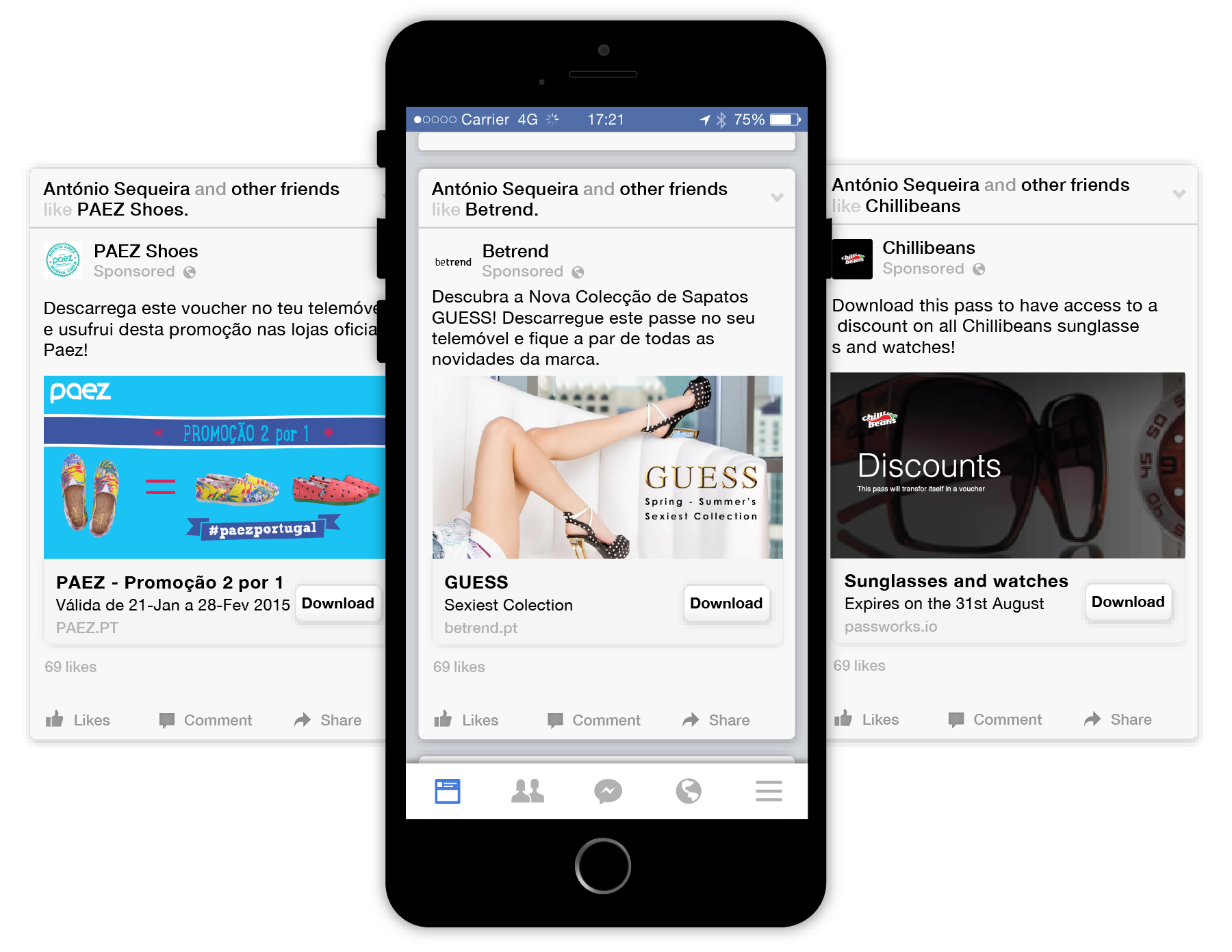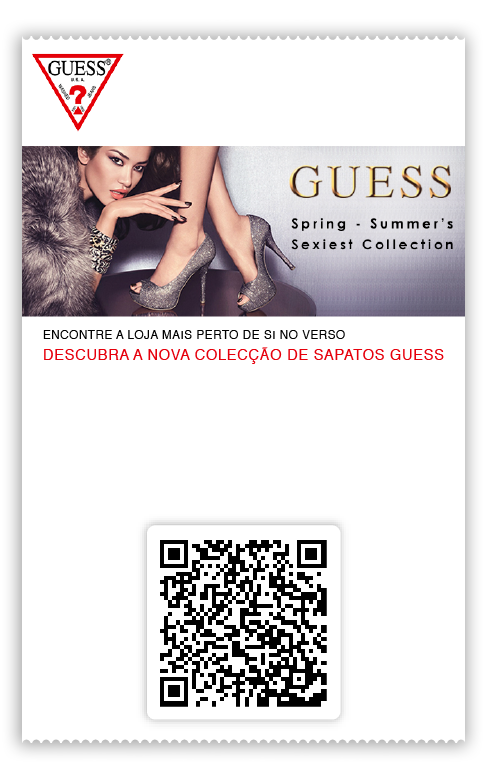Tag: Passbook
Apple’s Mobile Wallet
Chic by Choice went mobile (marketing)
Chic by Choice just created a pass* for Vogue Fashion Night Out, on the 10th September 2015, in Lisbon. To have access to the discount, just install this pass on your smartphone.
A Chich by Choice criou um passe para a Vogue Fashion Night Out, a decorrer amanhã, dia 10 de Setembro, em Lisboa. Para aceder ao desconto, apenas instale este passe no seu smartphone.
Have fun!
Divirta-se!
*campaign valid for Portugal
Já repararam que a ChilliBeans tem uma nova promoção??
The Questions Behind Mobile Wallets
Since the launch of Passworks several questions regarding the technology and the usage of the platform arose. We listed what are the most common doubts or questions that have been asked:
“What is Passbook? And what is it for?”
Passworks has been present in several marketing, retail and technology events as an exhibitor to show and explain how our technology works. Typically, Passworks generates huge interest from the visitors and a decent percentage have heard about Passbook application. Nevertheless, the majority of the visitors do not know or understand what is the purpose of Passbook and there are many questions about it: ”I have this app on my iPhone but I never use it. I don’t know what is it for.”.
At Passworks, we face this double challenge of having to demonstrate the benefits of our platform and technology, but also to go back and explain the concept of mobile wallets and Passbook.
Passbook is an Apple application, launched with iOS 6 on September 2012, pre-installed in all iPhones and iPod touch devices that allows users to store coupons, boarding passes, even tickets, store cards, and starting with iOS 8.1, credit cards, loyalty cards and debit cards via Apple Pay.
“Do I have to download an App?”
Many people believe that there is the need to download another App in order to have access to the mobile coupons, membership passes, tickets, etc. Incorrect. Passworks integrates with existing several wallet Apps, such as Passbook or Pass Wallet, in order for the user to just easily add the pass into that app.
“How do I receive the pass into my phone?”
This question is asked several times at the beginning when people start to understand the huge benefits that the technology brings.
Passes can easily be distributed into the users mobile via email, SMS, MMS, web links, integration with social media, an App or through scanning a QR code.
“Does it send trigger location-based notifications?”
Passworks technology enables brands to associate locations and messages to a specific pass, in order for the customers that has the pass installed receive a push-notification to remind them about the pass content when they are close to the pre-defined location.
“Can I insert unlimited locations to the platform?”
Unfortunately, the technology itself limits the number of locations to 10 places. Nevertheless Passworks developed several alternatives for bigger clients that wish to add much more locations.
“How Can I redeem the voucher?”
The brands have the possibility to add to the pass a barcode, that can be a QR Code, PDF 417, EAN 128 or Aztec. This code allows brands to count the number of passes issued and also can be read at point of sale via a classic POS scanner or using Passworks technology that includes a Scanner App or redeemer web page.
“Which KPI´s can I measure with the Passworks?”
KPI´s are an important part of the information required to determine and explain how a company progresses towards its business and marketing goals. Passworks understands that it is essential to provide a solution for brands to measure their campaigns.
Using Passworks platform you can access to several data regarding your campaign, such as number of passes download, installs, active passes, how many people have delete the pass and much more. Inclusive, If you decide to create personalized passes, like a membership card or a store card, you can even know the exact behaviour of each customer.
Those are the most common question, but if you have any other doubt don´t hesitate in reaching us at hello@passworks.io. We are here to help!
Nevertheless, have in consideration that the usage of Passbook is very different from country to country. As an example, in the United States Passbook is broadly used for mobile coupons, store cards and boarding passes. While in the UK the technology is on a more initial phase.
But the feedback we received from our customers and partners on the technology and Passworks is great. No doubts about the increase and growth of mobile wallet marketing that will allow brands to better engage with their customers in real-time and based on their location.
Why Passbook will be renamed Wallet
— Passbook —
Apple launched Passbook App in September 2012. Passbook is a pre-installed App with the purpose of dematerializing physical cards, tickets and coupons into mobile passes and storing them into one single place.
Since 2012, the passes have been gaining awareness among several industries, with a high focus on air travel and retail. Marketers caught the eye on a huge digital marketing potential by using Passbook to engage via mobile with their customers.
However, the commercial roll out and adherence, mainly from the brand´s side, of Passbook at the beginning was slow which let to a low usage and awareness. If Passbook was like a normal wallet why couldn’t it support payments? What was the point of it?
— Apple Pay —
In September 2014, Apple announced that it was partnering with Visa, MasterCard and American Express, which allowed consumers to store their credit and debit cards and to pay through their iPhones. In October 2014, with the official launch of Apple Pay at the United States for iPhones 6 and 6 Plus, all the messages and doubts were simplified as each Apps had their own roles. Just 6 months after the launch, Apple Pay acceptance and usage was growing fast, giving consumers access to contactless payments with Apple Pay in more than 700.000 locations.
On July 2015, and after a huge success on the US, Apple Pay was launched in the UK, supporting about 70 percent of all British credit and debit cards, and services such as Post Office and other popular stores and restaurants.
— Wallet —
A physical wallet contains all types of credit and debit cards, store cards, membership cards and papers, such as coupons or boarding passes. So, it´s natural that a mobile wallet, where all the above is also stored together uses the Wallet name to communicate the same purpose: commercial transactions and relationships between the consumer and the brand. Consequentially, in 2015 with the release of the new iOS 9, Apple merged both Passbook and Apple Pay Apps into one only brand named Wallet.
With the launch of IOS 9, there is a major change which is the possibility of having a new code: EAN 128. This will allow Apple Wallet to grow faster driven by both brands and POS acceptance. In addition to this add-on, thanks to the location-based features linked to Passbook and the new iOS Maps, Wallet now knows which card you need when you’re in a given store and presents the right option. Also, these passes can now be distributed through Safari or scanned using the built-in scanner inside the App.
Starting this fall, Apple Pay will support Walgreens Balance Rewards, Kohl’s, Coca-Cola, Dunkin’ Donuts, Panera Bread, and Wegmans.
Altogether, Apple Wallet presents itself as the main mobile wallet competitor. This statement translates in offering a stronger mobile marketing opportunity for brands, with a higher reach and effectiveness that no brand should refuse.
3 Tips to have in mind when defining a mobile strategy
In October 2014, the newspaper The Independent stated: “for the first time ever there are more gadgets in the world than there are people”. There are more than 7.2 billions of mobile devices in the world, which means that “mobile penetration has now risen above 100% in most developed markets, because many people have more than one live connection”. The acquisition of mobile devices such as smartphones and tablets are rapidly increasing per user, creating a bigger opportunity for brands to engage with their consumers.
It is important to have in mind that mobile isn’t only smartphones, so here are some important tips topics when creating a mobile strategy:
- Social media
Smartphones allow people to stay connected to the world and social media has been the fundamental driver of this connectivity. That is why social Apps are among the most installed, in the UK. According to App Annie’s: 4 out of 5 free downloaded Apps for iPhone users in the UK are social.
Social influence is also a gamification technique. Being part of a social community and the act of “shareability” allows driving engagement with other users using psychological influences, such as, acceptance, competitiveness, companionship or even desire.
There are many social Apps and tools that brands can use to interact with users. Since social is a personal contact, consumers feel more involved and are driven to a stronger relationship with brands, which increases the engagement and ultimately increases sales.
- Mobile Wallets
Mobile wallets are apps that allow to store cards, coupons, boarding passes, credit cards and much more in one single space. The most known mobile wallets are Apple’s Passbook and Google Wallet.
Passbook is a pre-installed app, which means that every person with an iPhone has automatically access to Passbook. Since 2013, Apple has already sold more than 200 million iPhones, this means that more than 200 million of consumers has direct access to Passbook (which will be rebranded as Wallet).
Google Wallet, on the other hand, is an App that has to be downloaded on the Google Play Store and is only available for the US market. Nevertheless, it has around 20 million users. Google Wallet is on the process of being rebranded as Android Pay and will be available globally which will allow to grow faster.
![]()
- Beacons
Beacons are small Bluetooth devices that act as a dynamic geo-mapping tool by emitting signals, and are currently a trend that keeps growing across industries.
Beacons empowers the brand’s App, because it allows to makes the content more dynamic and relevant since it is delivered according to the consumers’ location, without being to much intrusive for the consumers. This means, that a brand or retailer can send web links, discount promotions and notifications to the consumer, depending on its in-store location.
The hype around beacons is because they allow brands to create a richer, contextualized and personalized in-store consumer experience while getting to know better their customers.
For retailers or brands without Apps, Facebook just released their own beacons for retailers to use that integrates with Facebook App. This is an interesting solution for brands or small retailers without their own App because it takes advantage of Facebook and their social engagement since most users already allow Facebook App to send push notifications. In addition to this, Facebook links its own geo-located ads to the brand’s content, which minimizes the risk for brands.
Individually, each of the above tips explores mobile marketing as a channel to increase engagement with the consumer and to drive store traffic. Combined, the results are exponential, resulting in a much stronger mobile strategy to acquire, engage and retain customers.
The Benefits of Digital Event Tickets
In a world where we can download and add into our smartphone all sort of things, such as music, books, etc., doesn’t it makes sense to have that same with event tickets?
The waiting for a post delivery of the paper ticket, having to print a ticket beforehand or to go somewhere to pick them up can be a hindrance in an age where time is increasingly important.
The promise of digital wallets can change all that, and with Passworks you can create a pass for an event, turning a paper ticket in to a digital ticket, allowing the user to safely and easily keep it on his smartphone.
Once a pass is created it’s easy to distribute it to customers via email or SMS, with a straightforward link to open and add the digital ticket into their phone in Passbook, to be kept until it’s needed on the day of the event, be it a movie, concert, museum, sporting event etc.
The convenience of not having to carry around a physical ticket makes the whole process of buying and attending an event that much easier for the customer. There’s no longer the worry of losing the ticket or the hassle of having to find it in your wallet, not to mention the printing costs saved by all the new process.
The most impressive aspect of a digital pass over a paper ticket is that fact that it’s dynamic, meaning it can be updated with new information in the lead up to the event or to send a reminder the day before. That pass is also fraud-protected being each digitally signed.
The fumble around in your pocket in the queue is also eliminated via location-based technology implemented in the pass to appear on the users’ lock screen when they are in the proximity, further aiding an easy, stress-free way to store event tickets.
Digital event tickets make it even easier for event organisers to manage their customers as you can easily track their demographics as information is sent back to them from the pass, increasing understanding of their actions and behaviour.
3 Ways Social Media Can Enhance Your Mobile Wallet Marketing Campaign
Unless you’ve been living under a rock for the past years, you can’t fail to recognise the hugely important role and impact that social media had and is having in our lives. It has never been easier to contact a friend, reach someone and, more importantly, share information, which makes it essential for brands to have a social media presence.
A mobile wallet marketing campaign can also be boost by the benefits of what social media has to offer.
Take full advantage of it and use social media as an additional platform to create a buzz around your products, offers and increase awareness of your brand.
-
Create generic mobile coupons to be shared
A mobile coupon can be personalized to a specific user or generic in order to be massive, meaning that it can be shared and used by everyone. By sharing a mobile coupon it will increases awareness of your brand on social media and maximises the exposure to your offers, attracting and acquiring new customers.
A Facebook referral promotion campaign is a great example of how to empower the effectiveness of a generic mobile coupon. The promotion works by enticing fans to gain rewards by referring friends to sign up, meaning they effectively do a lot of the hard work for you. The initial action of liking your brand’s page is a simple and task-free one for the users which increases your fan base. Then in order to access the coupon, a sign up is needed, giving you access to new customers’ email addresses to add to your mailing list.
-
Link news feed posts to passes
Update your news feeds regularly with new information about the offers and to add the pass click the link to download. A pass will be added instantly into the smartphone’s digital wallet. That can include a generic offers pass that can be updated frequently with special promotions according to the brand strategy.
Your customers’ news feeds are also a springboard to attract new customers as their likes or retweets of offers will appear on their friend’s newsfeeds, making it more likely they will click on your page to see the offer if they know a friend has done it.
-
Make your customers aware of your technology
It’s key, that if you update your digital wallet technology content, to let your customers know the changes, and social media is a great place to communicate. As an example, if you’ve just incorporated your passes or loyalty card into Passbook, then updating your news feed to get that information over to your customer base is key.
Likewise, if you’ve introduced new technology in your stores, such as iBeacons, then sending information via social media allows to explain how it works encouraging your customers to try it.
A Guess tem novidades!
Para conhecer a nova colecção de sapatos Primavera / Verão ’15 e ficar sempre a par das próximas promoções apenas faça scan do código QR com o seu telemóvel para fazer download do passe ou clique em: http://buff.ly/1Jvi0HN! 🙂
Campanha válida para Portugal e presente nas lojas indicadas no verso do passe.
Boas compras!
Digital wallets, such as Passbook, are key to effectively use beacon push notifications
The premise of beacon technology has created a big buzz amongst marketers, who see the potential of a more personalisation and relevant customer targeting. However, it’s important they understand and exercise with caution how to use beacons in order not to be invasive and also to have the ability to create relevant, contextualize and personalised content.
Leveraging location-based technology will undoubtedly lead to a closer, more personal relationship in the way brands communicate to their customers. It presents a win-win situation for both brands and customers, as marketers can see better results from their campaigns and customers can get more relevant offers to their own tastes and likes.
However, some consumers, worry about privacy issues when brands can directly send messages to their phones and can also feel annoyed by too many push notifications or by the ones that are not relevant to them.
Positioning beacons in-store can counteract some of these issues, by taking advantage of the customer’s location for a more beneficial situation. Customer interactions with beacons will normally only happen after downloading a Passbook Pass or having a specific App, meaning there is already an opt-in by the consumer. Nevertheless, over-targeting, being too personal or sending to many push notifications can drive the customer’s to delete the Pass or uninstall the App.
The quantity and types of push notifications comes down to good judgement (common sense) and ultimately, thinking from the customer’s point of view about whether you would respond well to those specific messages. Research by Punchtab revealed that 88% would be willing to use location-based technology if it mean they would receive special offers or coupons. So, it´s key to provide value to the customer, giving him a good reason to be contacted.
Combining Digital Wallets, such as Passbook, with beacons are perfect for in-store push notification to easily allow customers to obtain passes and influence their in-store activity, with the goal of encouraging them to make a purchase. The seamless process of adding a pass on the go into the smartphone is becoming part of the future, and of how we shop with taking advantage of smartphones and digital wallets.
